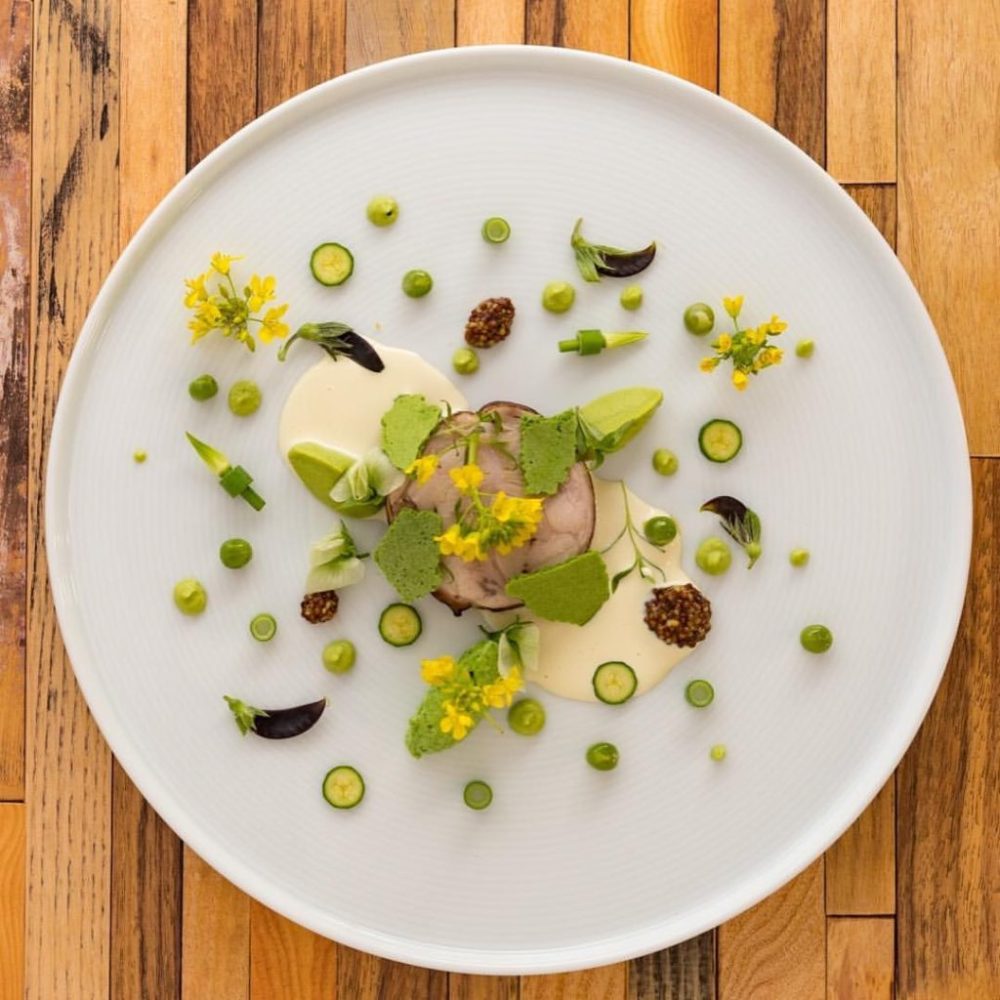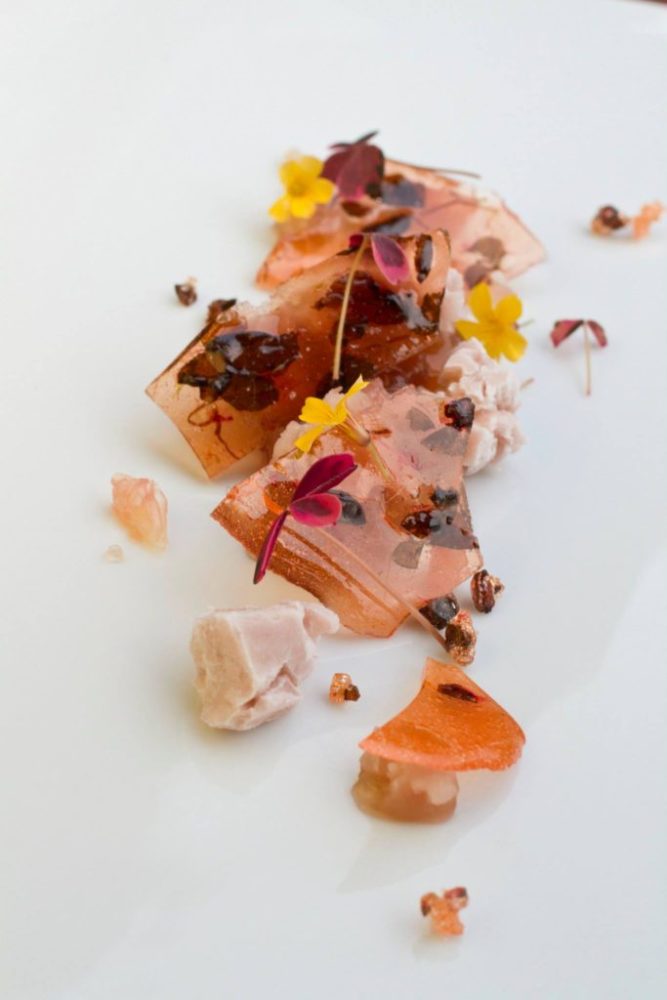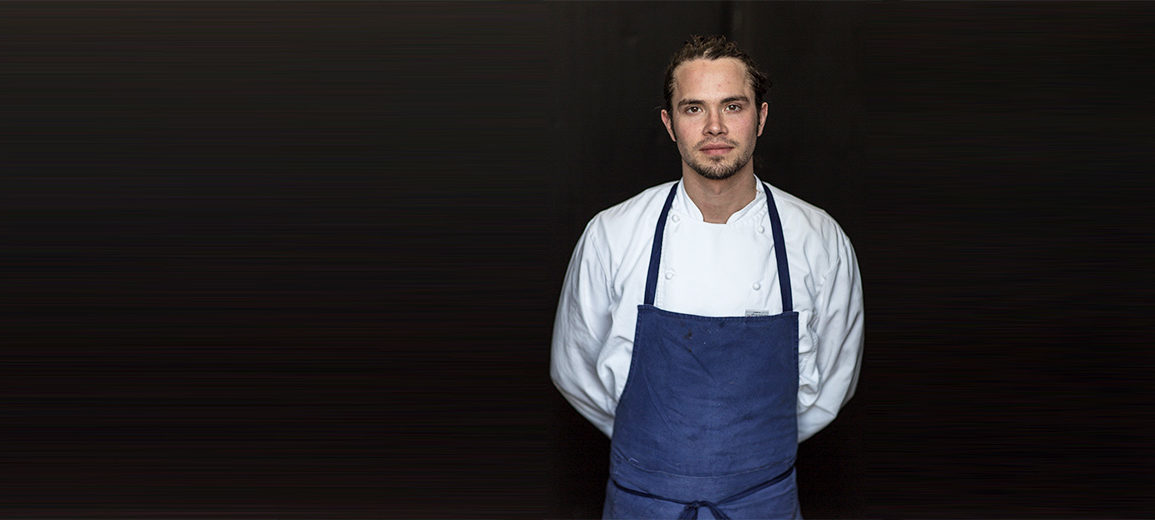Jamie Simpson, started as a rock musician before leaving the recording studio for the kitchen. Since then he has worked at some of the best restaurants in Charleston, SC and staged at Michelin-starred restaurants around the world. Today, he is the Executive Chef at The Culinary Vegetable Institute at The Chef’s Garden in Milan, Ohio. His passion – to promote and grow the sustainable food system.
You were previously in a rock band before becoming a chef. How has that had an effect on your creative process?
Imagine four notes in a chord, a harmony of independent tones working together to produce something compelling, or comforting. Now imagine how many different ways those four simple notes can be arranged with rhythm and accents to conjure distinct emotions and traditions through cultures around the world. This is food, an ingredient is simply a note in a chord. A great dish is a great song and a great restaurant is an absolute symphony.
The Chef’s Garden is the host of the annual two-day Roots Conference. The conference gathers around topics and people, wanting to improve our food system. What are some farm-to-table topics that have changed your outlook?
It is no secret that the food system in America is incredibly wasteful. Every stage of production and distribution in this country from a field to your garbage can equal approximately 40 percent total waste. That means if America grows 10 pounds of carrots, only 6 pounds will ever be consumed and 4 pounds will be thrown away. Distributors and grocery stores are a major cause. I find this troubling. Anything we can do to better understand this issue and take action on it will be a powerful example to set for the future. For over 30 years The Chef’s Garden has been at the forefront of influence. It is important that we understand these issues and handle them responsibly to spread the seeds of inspiration to other farms, homes, grocery stores and restaurants, small or large. In the kitchen, the weight of our trashcan ultimately defines the true success of our business. This model is no different for the planet.

How has The Culinary Vegetable Institute put sustainability at the forefront?
Last year I certified the kitchen at The Culinary Vegetable Institute, as a cannery. We can legitimately preserve our way through the seasons and make the most of what nature provides naturally and sustainably. For the operators out there, our food cost for 2016 averaged 23%. This was done in a facility that is only open for public dinners 3 to 4 times a month and private dinners 2 to 3 times a week. Every dish ever served is different from the last and I purchase all of my ingredients from the farm as well as other suppliers. The Culinary Vegetable Institute’s root cellar is more than pickles. Its miso and vinegars, bitters and amaros, root vegetables, dried fish, dried seeds, hams, cheeses, whey ferments, and a bunch of random stuff that may or may not ever be reproduced. The 2017 focus is to produce a product line that is developed from potential agricultural waste and distributed at wholesale or retail through the hands at the Culinary Vegetable Institute.
Chef’s Garden produce can be found in kitchens all over the U.S. as well as in the UK. What are some sustainable practices that The Chef’s Garden uses when transporting vegetables to kitchens around the world?
When you call and order vegetables from The Chef’s Garden, the produce is then harvested, packed and delivered directly to restaurants as far as Hong Kong and Dubai. Local isn’t a measure of quality. There are several things Chef’s Garden takes into account that I personally take pride in.
1. The produce is harvested after the product is ordered which greatly increases its shelf life and results in less waste.
2. Direct delivery eliminates a middleman and unnecessary storage warehouses (i.e. distributors that refrigerate produce for months on end) that result in the consumption of less energy.
3. Carpooling with companies like Fed-Ex ensures efficiency. The success of their business purely relies on their ability to efficiently distribute products globally.
4. Our packaging is 100% recyclable. There’s currently new testing on Carbon Fiber retrievable boxes. These retrievable boxes are designed to distribute organs in the medical field and can maintain temperatures within just a few degrees for days.
“If intricate yet approachable is how you describe my plates, it’s also how I hope you might describe me as a chef, better yet, a human.”

What are some underrated vegetables we should be using during the spring season?
There are so many underrated vegetables in the spring. My favorite being pink, green, purple, and white asparagus small or large; Mr. Frye’s rhubarb for savory applications; wintered over root vegetables; petit pois; very young pheasant back mushrooms; squash leaves; sorrels; green garlic; garlic root; hibiscus and green strawberries.
The Culinary Vegetable Institute has hosted some of the most influential chefs. Who has been the most memorable Chef you’ve had the pleasure of cooking with?
We have on average about 600 visiting chefs a year. This is a bucket list destination for culinary minds. I’ve worked with many of them and to name only one would be a crime.
Gunnar Karl Gíslason of Dill Restaurant in Iceland and Agern, in New York City, for his genuine approach to food that speaks its own language that represents his culture.
Brad Kilgore of Alter and Brava both in Miami, for his flavor profiles that haunt me. (i.e. caramelized white chocolate and artichoke barigoule with octopus)
Cortney Burns of Bar Tartine in San Francisco, for her scholarly grip on food, preservation and her understanding of how history relates to the future with a constant thirst for learning more.
Eli Kaimeh of Per Se in New York and Phil Tessier of French Laundry in Yountville from Thomas Kellar Group and Bocuse d’Or. Their unwavering pursuit of perfection supported by an impossible focus and passionate drive inspire me.
Champe Speidel of Persimmon in Rhode Island, for his deep respect and understanding of food. Though he has a great reputation back home, he is easily among my list of ten most underrated chefs in this country.
Ronny Emborg of Atera in New York City, for his art in food that has influenced every big chef on Instagram whether they know it or not and for his willingness to always teach others.
Antonio Bachour of Bachour Bakery in Miami, for creating a language in desserts that is both compelling and teachable. He is easily among the top most influential pastry chefs of this decade and a productive monster in the kitchen.

Has your cooking style evolved in keeping with the increase in popularity of sustainable agricultural practices?
My cooking style has evolved organically and will always represent time and place. To look at every ingredient for the first time, every time, is my most powerful weapon of creativity. This is what allows us to produce over 1000 new dishes a year. Our biggest philosophical strength in food and agriculture is allowing every part of a plants life an opportunity to present itself on a plate.
Who are some of the chef’s you most admire?
I most admire the chefs who have found their own voice. Whether it’s through activism or artistry, cooking for a cause is the most powerful thing we can do in this industry.
Who do you follow on Instagram?
I only follow about 100 people on Instagram and they’re all friends or organizations who represent the aforementioned.
With intricate yet approachable details, your plating style always tells a story. How did you hone your technique? (i.e. chef mentors, music, chefs you admire etc.)
Every moment in life presents an opportunity to tell a story. I don’t turn off the creative process when I walk out of the kitchen. When you walk through an art museum and see a da Vinci, van Gogh, Picasso or Dali you can unarguably identify the artist even if you’ve never seen that particular painting. This same concept relates to the most famous musicians, ceramicists, clothing designers, carpenters, architects, and certainly chefs. So to answer your question, I am always looking for ways to better communicate who I am as a person and what I represent. If intricate yet approachable is how you describe my plates, it’s also how I hope you might describe me as a chef, better yet, a human.

Photography Credits: James Douglass Shields, Hugo Juarez and Michelle Demuth-Bibb
 The Culinary Vegetable Institute at The Chef’s Garden in Milan, Ohio provides the world’s most innovative chefs with a place to share knowledge, experiment and discover techniques for growing and preparing the most flavorful varieties of vegetables in the world. The collaboration between the garden farmer and the chef and between the old and the new is the foundation of the Culinary Vegetable Institute. For more information visit chefs-garden.com and culinaryvegetableinstitute.com or call 419.499.7500.
The Culinary Vegetable Institute at The Chef’s Garden in Milan, Ohio provides the world’s most innovative chefs with a place to share knowledge, experiment and discover techniques for growing and preparing the most flavorful varieties of vegetables in the world. The collaboration between the garden farmer and the chef and between the old and the new is the foundation of the Culinary Vegetable Institute. For more information visit chefs-garden.com and culinaryvegetableinstitute.com or call 419.499.7500.


